 |
| Turiang |
28 Oct 2001
|
|||
| Last modified: 28 Oct 2001 |
The Si-Satchanalai ware on the Turiang is made of two different clays. The first is a secondary (lower grade) clay which varies from brick-red to a dark grey-brown to almost black. The second is a near-white clay, often with a yellowish cast. Both types are densely speckled with tiny black impurities, contrasting with the larger white specks in Sukhothai clay. None of these clays are even remotely similar to the uniformly light grey clay used for the mature celadon on the Royal Nanhai and Longquan wrecks. The clay used for the Nanyang celadon was different again: creamy in texture and colour.
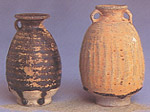 This
crudely-potted, heavy ware is made with the dark clay, unevenly mixed. A thin
opaque glaze generally stops well short of the base, although often running
down messily. These ceramics are referred to by TCAP as 'Mon ware'.
This
crudely-potted, heavy ware is made with the dark clay, unevenly mixed. A thin
opaque glaze generally stops well short of the base, although often running
down messily. These ceramics are referred to by TCAP as 'Mon ware'.
The early brown-glazed wares recovered from the Turiang include ring-handled bottles, mostly with a flared mouth, 9-13cm high. They have a flat base, often with curved concentric lines which result from being cut from a turning wheel with a fine cord. Some have thin handles which stretch down the body. The shapes vary considerably: many are tall and narrow, others bulbous, and others almost pear-shaped. Some have vertical or slanting striations.
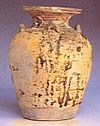
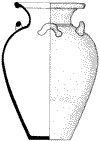 Many
storage jars of this ware were found, mostly broken at the neck; many are still
buried in the seabed. Three were recovered. They have four lug handles and a
flared mouth. They are 33cm high and would hold about 12 litres of liquid. The
flat base is made from a distinct disc of clay, on which the walls were coiled.
Of the samples, one is marred at the top by blisters from trapped air bubbles.
Some much larger storage jars were too big to be retrieved to date; similar
examples from the Royal Nanhai had a capacity of 75 litres and contained
fishbones.
Many
storage jars of this ware were found, mostly broken at the neck; many are still
buried in the seabed. Three were recovered. They have four lug handles and a
flared mouth. They are 33cm high and would hold about 12 litres of liquid. The
flat base is made from a distinct disc of clay, on which the walls were coiled.
Of the samples, one is marred at the top by blisters from trapped air bubbles.
Some much larger storage jars were too big to be retrieved to date; similar
examples from the Royal Nanhai had a capacity of 75 litres and contained
fishbones.
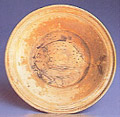
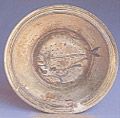 The
early Si-Satchanalai underglaze ware, painted on slip, uses the Mon clay, and
is also characterised by TCAP as 'Mon ware'. The underglaze decoration is painted
over a thin yellowish-white slip which, in contrast to the Sukhothai ware, is
carefully applied. The slip is generally applied over the whole shape, including
the exterior of the foot-ring. Foot-rings are well carved, with tapered sides
and a shallowly recessed base in which accidental patches of slip can be noticed.
Rims have a raised lip, more pronounced than on the Sukhothai counterparts.
The
early Si-Satchanalai underglaze ware, painted on slip, uses the Mon clay, and
is also characterised by TCAP as 'Mon ware'. The underglaze decoration is painted
over a thin yellowish-white slip which, in contrast to the Sukhothai ware, is
carefully applied. The slip is generally applied over the whole shape, including
the exterior of the foot-ring. Foot-rings are well carved, with tapered sides
and a shallowly recessed base in which accidental patches of slip can be noticed.
Rims have a raised lip, more pronounced than on the Sukhothai counterparts.
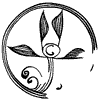 |
 |
 |
All of the Si-Satchanalai underglaze ceramics on the Turiang are plates, 25.5-27cm in diameter and 4.5-6.5cm high. Most have fish and flower decorations. The fish designs are less exuberant than the Sukhothai versions, but more carefully drawn, frequently with foliage trailing from the mouth. The floral designs are very stylized, and so far unique to Si-Satchanalai, with no hint of other origin. The glaze, where it remains, is generally clear with a green tinge, but sometimes glassy, crackled and dark green.
Most of the plates have spur marks in the lower interior, and a few have the circular impression of a tubular firing support on the base. The circular support scars are less pronounced on the Turiang plates than the black scars seen on later Si-Satchanalai ware, such as the mature celadon from the Royal Nanhai and Longquan wrecks. Later supports appear to have been attached with some sort of glue (so that the support could be used as a handle for dipping into the glaze), whereas the slight depressions on the ceramics from the Turiang and Nanyang seem to have been from simply supporting the unfired objects in the kiln.
 Whereas
all Sukhothai underglaze dishes on the Turiang have pitted glaze, the
remaining glaze on the Si-Satchanalai ware shows no evidence of pitting. Similar
underglaze wares using the finer clay without slip are referred to by TCAP as
'Mon associated stoneware'. There are two examples of the latter on the Turiang,
including the plate in the next photograph. These plates are covered with a
thick glaze which survived better than the glaze on other early Si-Satchanalai
underglaze wares.
Whereas
all Sukhothai underglaze dishes on the Turiang have pitted glaze, the
remaining glaze on the Si-Satchanalai ware shows no evidence of pitting. Similar
underglaze wares using the finer clay without slip are referred to by TCAP as
'Mon associated stoneware'. There are two examples of the latter on the Turiang,
including the plate in the next photograph. These plates are covered with a
thick glaze which survived better than the glaze on other early Si-Satchanalai
underglaze wares.
This has no slip, and a watery glaze ranging in colour from pale to dark green, suggestive of an underdeveloped celadon glaze. The same near-white clay with black impurities is used. Foot-rings are not as well formed, and frequently there is no recess in the base. Generally only traces of glaze remain: many objects appear to have been underfired, allowing the glaze to peel away. These ceramics were referred to by TCAP as 'transitional stoneware'.

 The
Turiang carried early green-glazed bottles of many shapes and sizes,
including a number which are roughly spherical and have two ring handles. The
largest of these are about 15cm high and undecorated; they have the size and
shape of coconuts and are disrespectfully known as 'coconut jars'. Small 'jarlets'
are 7-8.5cm high. The ring-handled jarlets and the medium-sized jars, 10-12cm
high, are decorated with two rows of vertical striations. They are unglazed
inside. (Over ten thousand jarlets were found on the Royal Nanhai, but
only small numbers on the Nanyang and Turiang. Jarlets have been
found in burial sites throughout Southeast Asia, and in the Philippines were
used to hold perfume, cosmetics, medicines and charms¹.
In the jarlets on the wrecks, there is no evidence of contents. The large quantity
on the Royal Nanhai is intriguing.)
The
Turiang carried early green-glazed bottles of many shapes and sizes,
including a number which are roughly spherical and have two ring handles. The
largest of these are about 15cm high and undecorated; they have the size and
shape of coconuts and are disrespectfully known as 'coconut jars'. Small 'jarlets'
are 7-8.5cm high. The ring-handled jarlets and the medium-sized jars, 10-12cm
high, are decorated with two rows of vertical striations. They are unglazed
inside. (Over ten thousand jarlets were found on the Royal Nanhai, but
only small numbers on the Nanyang and Turiang. Jarlets have been
found in burial sites throughout Southeast Asia, and in the Philippines were
used to hold perfume, cosmetics, medicines and charms¹.
In the jarlets on the wrecks, there is no evidence of contents. The large quantity
on the Royal Nanhai is intriguing.)
 The
Turiang cargo also included plain mini-jarlets without handles, 4.5-7cm
high; tall bottles with two ring handles, 18.5-20cm high with a flat or shallowly-recessed
base and vertical striations; bottle vases; and covered jars. No dish-shapes
have yet been found in the early green-glazed ware.
The
Turiang cargo also included plain mini-jarlets without handles, 4.5-7cm
high; tall bottles with two ring handles, 18.5-20cm high with a flat or shallowly-recessed
base and vertical striations; bottle vases; and covered jars. No dish-shapes
have yet been found in the early green-glazed ware.
 |
 |
The bottle-vases are of two types. One is decorated with vertical striations and/or carved rings. The other, made of notably lighter clay, has incised decoration, common on later celadon. One pear shaped bottle-vase of the latter type, 27cm high, features a stylized peacock with elaborate cloud motifs.
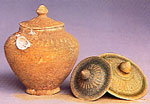
 Four
covered jars recovered had lids with lotus-bud handles. These were of three
different sizes (12-13, 15, and 18cm high, without the covers). The two smallest
jars are still sealed, and are decorated with wide striations; the others have
carved rings at the shoulder.
Four
covered jars recovered had lids with lotus-bud handles. These were of three
different sizes (12-13, 15, and 18cm high, without the covers). The two smallest
jars are still sealed, and are decorated with wide striations; the others have
carved rings at the shoulder.
Another early green-glazed item worth mention is a 'guan' style jar, 18cm high and 25cm in diameter. This pot is similar in form to a Chinese guan jar found on board, although the structure is different and the Thai jar has very little trace of decoration. It is interesting that two similar products of different origin are found on the one wreck.
| Turiang overview | Maritime Asia homepage | Next: Vietnamese ceramics on board |